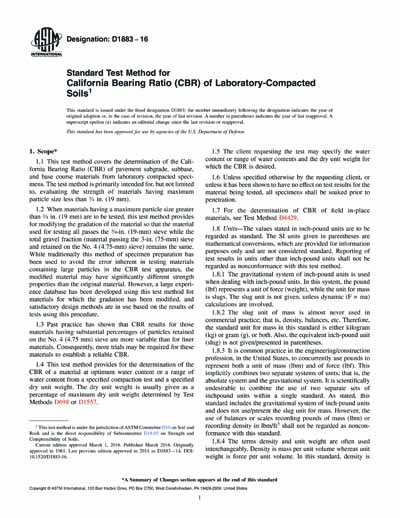Historical
ASTM D1883-16
Standard Test Method for California Bearing Ratio (CBR) of Laboratory-Compacted Soils
1.1 This test method covers the determination of the California Bearing Ratio (CBR) of pavement subgrade, subbase, and base course materials from laboratory compacted specimens. The test method is primarily intended for, but not limited to, evaluating the strength of materials having maximum particle size less than 3/4 in. (19 mm).
1.2 When materials having a maximum particle size greater than 3/4 in. (19 mm) are to be tested, this test method provides for modifying the gradation of the material so that the material used for testing all passes the 3/4-in. (19-mm) sieve while the total gravel fraction (material passing the 3-in. (75-mm) sieve and retained on the No. 4 (4.75-mm) sieve) remains the same. While traditionally this method of specimen preparation has been used to avoid the error inherent in testing materials containing large particles in the CBR test apparatus, the modified material may have significantly different strength properties than the original material. However, a large experience database has been developed using this test method for materials for which the gradation has been modified, and satisfactory design methods are in use based on the results of tests using this procedure.
1.3 Past practice has shown that CBR results for those materials having substantial percentages of particles retained on the No. 4 (4.75 mm) sieve are more variable than for finer materials. Consequently, more trials may be required for these materials to establish a reliable CBR.
1.4 This test method provides for the determination of the CBR of a material at optimum water content or a range of water content from a specified compaction test and a specified dry unit weight. The dry unit weight is usually given as a percentage of maximum dry unit weight determined by Test Methods D698 or D1557.
1.5 The client requesting the test may specify the water content or range of water contents and the dry unit weight for which the CBR is desired.
ASTM International [astm]

